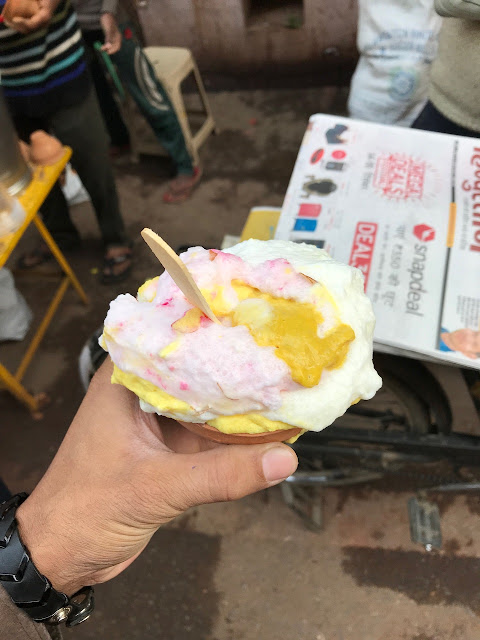Waking up to a sweet
A Mouthful of Heaven
A slightly edited version finds place in TheHindu Sunday Magazine.
Thank you : The team at The Hindu, Richa and Kumar.
Sometime last year, during a book launch, I got to interact with the author after listening to his eloquent talk. He, a European, in turn, asked me if my name meant ‘that yellow coloured soft sweet which is had in the mornings’. I was already a fan of Malaiyo, which fits the description, but could not figure out what he meant!
A few weeks later, a friend asked if my name meant a Lucknowi
dish available only during winters. A sweet similar to the Daulat ki Chaat she
had had at Old Delhi. Vir Sanghvi’s account of the street
food festival, at Delhi, where Banaras took the honours, had prompted her
question. By this time, I was intrigued and looked up more on Malaiyo, Daulat
ki Chaat and of course Nimish. It turns out the dish also has a fourth name –
Malai Makhan.
Ashish Mamgain in his article ‘If
you could eat the clouds . .’ clarifies,
‘The same ‘chaat’ is available in other parts of north India, but it goes by
different names, such as Malai Makhan in Kanpur, Malaiyo in Varanasi, and
Nimish in Lucknow’. In love with the sweet, he adds, ‘The moment you put it in
your mouth, it just melts away. So much so, that a person trying it for the
very first time is very likely to be left bemused’. Sabyasachi
Roy Choudhury clarifies further, ‘The dish has subtle differences from
place to place. Silver foil, rose water and mawa are some ingredients in these
variations’.
Chand
Sur and Sunita Kholi in their ‘The
Lucknow Cookbook’ (Aleph, 2017) describe Nimish as ‘famous and unique
Lucknow specialty’. Further details include ‘the basic preparation of Nimish is
when milk is poured into large flat pans and left in the open before dawn. When
the early morning dew falls on the milk, it creates a froth which is as light
as air’. The dish, however, does not find mention in Mirza
Jafar Hussain’s, ‘The
Classic Cuisine of Lucknow: A Food Memoir’ (Sanatkada Publications, 2016).
Conversation with another friend who has grown up in Old Delhi
reaffirmed what I had come across on the web – that the ‘cloud’ had disappeared
some years ago and has made a comeback of sorts during recent times. Rahul
Verma enjoyed it at Jashn E Rekhta
- a festival celebrating Urdu and described it as ‘the best desert in the
world’.
At Banaras I had a conversation with Somnathbhai who sells
Malaiyo near Chowk; in between his brisk sales. As he handed over the ‘cloud’
in kullads he shared how Chowk and Chowkhamba, read the heart of Banaras,
continue to remain THE localities in town for Malaiyo. The season for Malaiyo
is the period between Diwali and Shivratri. Even within these, sales tend to dip
post Makarsankranti; seasons still dictate the food here. As we extended our
hands with the empty kullads, for re-fill – this time with milk; he proudly
mentioned his having introduced flavours like chocolate and strawberry and of getting
orders for parties during the ‘season’. The cost of a serving, approximately
30/-, includes the refill with milk.
I also talked with friends and acquaintances in Banaras. One
of them mentioned that malaiyo was also an early morning offering to the deity
in select temples. Some friends swear by it and others lament their not being
able to have it. The later suffer from ‘being busy’. Of those who savour it few
are glad that select outlets now make it available throughout the day while others
conveyed that the ‘asli’ stuff is available only during the mornings.
Malaiyo I can savour before breakfast, after breakfast and
both before and after breakfast. In each of these scenarios I usually end up in
silent contentment. I am yet to figure out how a dish which appears so light
gives such satisfaction. Perhaps, there is a message here!
Not everyone in Banaras is crazy about it though. At a
school, located at the town’s out-skirts, I asked students of it. Studying in 8th
class none of them had yet had it. Most of them belong to families located on
the lower rungs of the social and financial ladders. I wondered if distance of
their homes from the Malaiyo hub was also a factor.
Coming back to the friend who had initially talked of it
with me. She was somewhat apprehensive of the quality of milk and the processes
put to use to make the Daulat ki chaat in today’s time.
I would rather side with Pamela Timms here. In her
mouth-watering book ‘Korma,
Kheer and Kismet: Five seasons in Old Delhi’ she writes ‘It resembles
uncooked meringue and the taste is shocking in its subtlety, more molecular
gastronomy than raunchy street food, a light foam that disappears instantly on
the tongue, leaving behind the merest hint of sweetness, cream, saffron, sugar
and nuts; tantalizing, almost not there. I’ve often wondered if it is a preview
of what might be on the menu should we make it as far as the pearly gates’.
More on Banaras
Sankat
Mochan Sangeet Samaroh (FirstPost)
Ramleela
(FirstPost)
Dhrupad
Mela (FirstPost)
Dufferin
/ Double-decker / Rajghat Bridge (The Hindu)
Laat
Bhairav (The Hindu)
Harmony
Bookstore (The Purple Pencil Project)


Lovely. Wants to make me run to north india to have it immediately ... notwithstanding a personal near-ban on processed sugar!
ReplyDeleteWelcome ~ Still on for few weeks ~
Delete